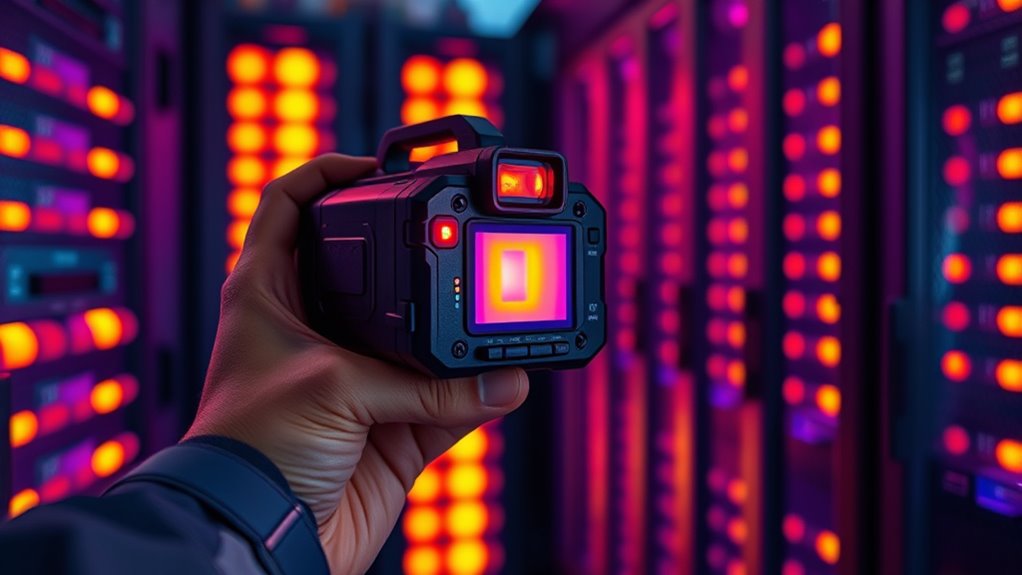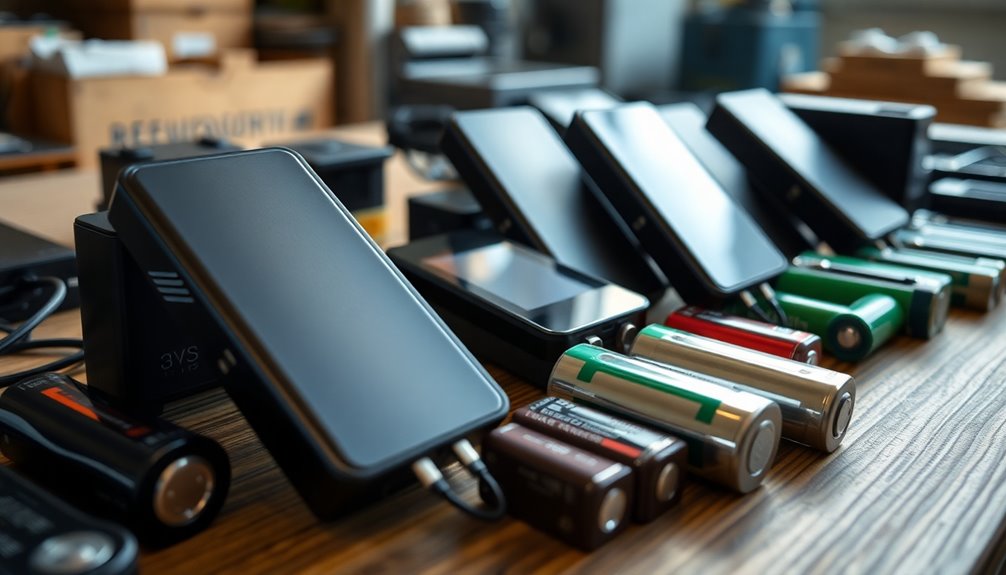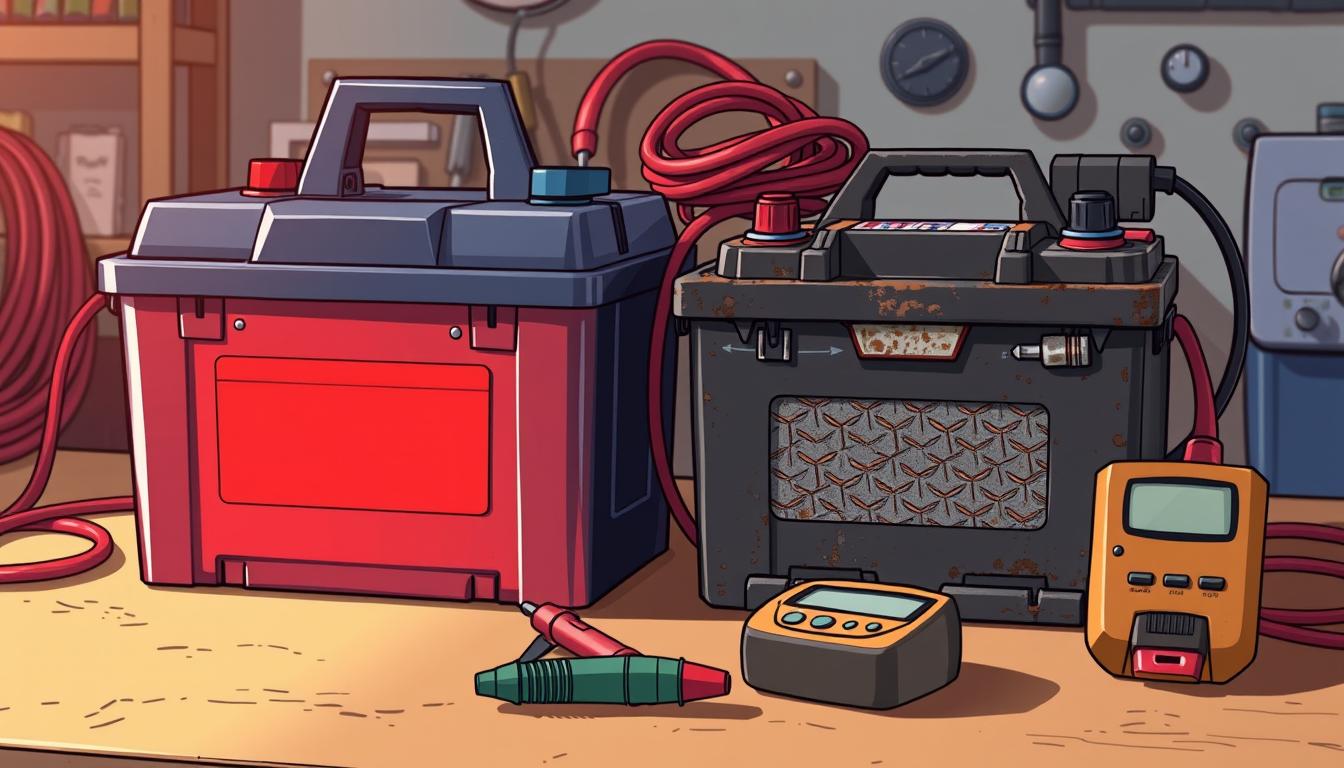When choosing an infrared camera for battery work, prioritize models with high thermal sensitivity (around 50 mK) for detecting subtle temperature differences. Opt for higher resolution sensors, like 320×240 pixels, to spot small hotspots or issues. Make sure the camera has a suitable range and adjustable focus for precise inspections at various distances. Durability and battery life are also key for extended, demanding inspections. Keep these factors in mind, and you’ll find the right camera—plus, there’s more to learn to optimize your choices.
Key Takeaways
- Prioritize low thermal sensitivity (around 50 mK) for detecting subtle temperature differences in battery systems.
- Select higher resolution cameras (e.g., 320×240 pixels) for detailed imaging of small hotspots.
- Ensure the camera has an appropriate field of view and adjustable focus for inspecting various battery sizes and environments.
- Opt for models with sufficient detection range to cover typical inspection distances without repositioning.
- Choose durable, weather-resistant devices with long battery life for reliable performance during extended battery inspections.

Have you ever wondered how night vision devices or thermal scanners detect heat in complete darkness? It all comes down to thermal imaging technology, which allows these devices to visualize heat signatures rather than relying on visible light. When choosing an infrared camera for battery work, understanding camera specifications becomes essential to guarantee you get the right model for your needs. Not all thermal imaging cameras are created equal, and their specs directly impact performance, usability, and durability in demanding environments.
First, consider the thermal sensitivity of the camera. This specification indicates how small a temperature difference the device can detect. For battery work, where pinpointing slight temperature variations can reveal potential issues like overheating or insulation failure, a camera with high thermal sensitivity—often measured in millikelvins (mK)—is indispensable. The lower the mK value, the more precise your thermal readings will be. If you’re inspecting electrical panels, for instance, a camera with a sensitivity of 50 mK or better allows you to identify problems before they escalate.
Next, look at the resolution of the thermal sensor. Camera specifications often specify the number of pixels in the thermal sensor, such as 160×120 or 320×240. Higher resolution sensors provide more detailed images, which helps you identify small hotspots or subtle temperature differences across complex components. When working in tight spaces or with intricate battery packs, a higher resolution guarantees you don’t miss critical details. Keep in mind that higher resolution models might be more expensive, but they can save you time and prevent costly mistakes.
Another essential aspect is the camera’s field of view (FOV). A wider FOV lets you scan larger areas quickly, which is beneficial when inspecting large battery packs or entire systems. Conversely, a narrower FOV offers more detail at close range. Some cameras also feature adjustable focus, giving you flexibility in different scenarios. Additionally, consider the thermal imaging range—how far the camera can accurately detect heat signatures. For battery work, a range that covers your typical inspection distances is ideal.
Finally, examine the durability and battery life of the camera. If you’re working in rugged environments, look for models with sturdy construction, good grip, and weather resistance. Battery life is equally important—longer-lasting batteries reduce downtime, especially during extensive inspections. Some models also offer quick recharge features or supplementary batteries to keep you working efficiently. It’s also beneficial to understand thermal sensitivity to ensure your camera can detect the smallest temperature differences relevant to your work.
Frequently Asked Questions
How Long Do Infrared Camera Batteries Typically Last During Extended Use?
During extended use, your infrared camera’s battery life varies based on the model and usage. Typically, batteries last between 2 to 4 hours, but heavy use can drain power faster. Good power management, like lowering screen brightness or turning off unnecessary features, helps prolong battery life. Always carry spare batteries if you’re working long hours, so you won’t run out of power when you need it most.
Are There Specific Infrared Cameras Designed for Harsh Outdoor Environments?
Imagine a camera built to brave the elements with ease. Many infrared models feature outdoor durability and rugged design, making them ideal for harsh environments. These cameras resist dust, moisture, and extreme temperatures, ensuring reliable performance. When choosing one, look for models specifically engineered for outdoor use, so you can work confidently in challenging conditions without worry. This way, your inspections stay precise, no matter how tough the weather gets.
Can Infrared Cameras Detect Battery Issues in Real-Time?
Yes, infrared cameras can detect battery issues in real-time through thermal imaging. You can monitor temperature variations within batteries, which helps identify problems like overheating or potential failures. Using thermal imaging for battery diagnostics allows you to quickly pinpoint issues without dismantling the system. This real-time detection improves maintenance efficiency and prevents unexpected failures, making infrared cameras a valuable tool for proactive battery management.
What Maintenance Is Required to Keep Infrared Cameras Functioning Properly?
Did you know regular maintenance can extend your infrared camera’s lifespan by up to 30%? To keep it functioning properly, you should perform routine lens calibration to ensure accurate readings. Additionally, proper battery preservation—like avoiding extreme temperatures and fully discharging—prevents battery degradation. Regularly clean the lens and check connections, and store the camera in a cool, dry place. These simple steps keep your infrared camera reliable for battery work.
How Do Different Infrared Camera Resolutions Impact Battery Work Accuracy?
The resolution impact directly affects your battery work accuracy by determining image clarity. Higher resolution cameras capture more detailed thermal images, making it easier for you to identify issues precisely. Lower resolution models may miss subtle temperature differences, leading to less accurate readings. When selecting a camera, consider how resolution influences your ability to detect problems quickly and accurately, ensuring you get reliable results for maintenance and troubleshooting tasks.
Conclusion
Choosing the right infrared camera for battery work guarantees accurate, reliable results. By understanding your needs and comparing features, you’ll find a model that fits perfectly. Remember, “the right tool for the job” makes all the difference—so take your time and select wisely. With the right infrared camera in hand, you’ll confidently diagnose issues and keep things running smoothly. Don’t rush the process; it’s better to be thorough than sorry later.










